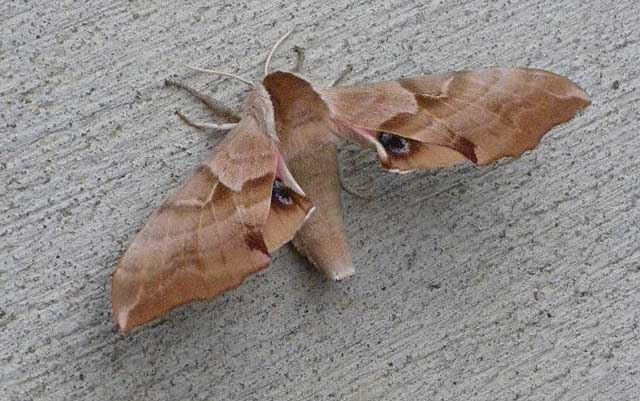Lane County
Sphingidae
Smerinthus ophthalmica, Veneta, Lane County, Oregon,
August 9, 2013, courtesy of Ellen Castellini
|
|
Updated as per James P. Tuttle's The Hawk Moths of North America, June 2009 Updated/dedicated as per personal communication with Ellen Castellini, (Smerinthus ophthalmica, Veneta, August, 9, 2013); August 10, 2013 |

It is hoped that this checklist, with the thumbnails and notes, will help you quickly identify the moths you have encountered.
A WO" after the species name indicates that I have no confirmed reports of this species in Lane County, but I (William Oehlke) expect that this moth is present.
Please help me develop this list with improved, documented accuracy by sending sightings (species, date, location), preferably with an image, via email to Bill Oehlke.
This page is dedicated to Ellen Castellini who provides the Smerinthus ophthalmica image at top of page.
I am pretty sure that the Smerinthus cerisyi and Hemaris diffinis, listed by USGS, are now considered to be
Smerinthus ophthalmica and Hemaris thetis, respectively. (Bill Oehlke)
d
Visit Lane County Sphingidae Larvae.
Visit Oregon Catocala: Underwing Moths.
Sphinginae subfamily
Smerinthini Tribe:
Macroglossinae subfamilyDilophonotini tribe
Macroglossini tribe
|
Eggs of many North American species are offered during the spring and summer. Occasionally summer Actias luna and summer Antheraea polyphemus cocoons are available. Shipping to US destinations is done from with in the US.
Use your browser "Back" button to return to the previous page.
This page is brought to you by Bill Oehlke and the WLSS. Pages are on space rented from Bizland. If you would like to become a "Patron of the Sphingidae Site", contact Bill.
Please send sightings/images to Bill. I will do my best to respond to requests for identification help.
 Show appreciation for this site by clicking on flashing butterfly to the left. The link will take you to a page with links to many insect sites. |